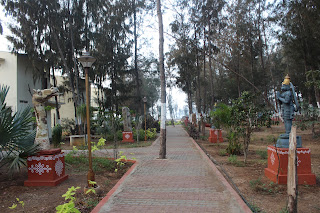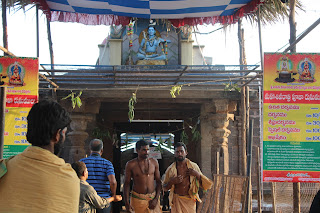Published in Airports India in April 2018
Konaseema, a beauty waiting to be explored
A tryst with the Godavari in Konaseema sounds interesting. A travel buff with wheels for feet, the urge to explore this hitherto little-known tourist region in Andhra Pradesh, is compelling. The decision made, my husband and I are on board Prashanti Express, on our way to Rajahmundry. It is from here that the Godavari branches to give form to the islands of Konaseema in East Godavari district.
A two-hour drive from Rajahmundry Railway Station brings us to Dindi’s Haritha Coconut Resort, nestled scenically in the midst of a dense coconut groves, overlooking the mighty river. We make Dindi, a picturesque village on the banks of the Vasishta, a branch of the Godavari, as base for our explorative sojourn.
We instantly warm to our surrounds and the view from our room is breathtaking. The Chinchinada Bridge that separates East Godavari and West Godavari looms scenically over our resort, punctuated in places by the arching palm trees.
We are happy with our choice of Konaseema, aptly nicknamed as “the Kerala of Andhra Pradesh” as holiday destination. This serene and scenic cluster of island villages with lakes, lagoons, streams and palm-fringed canals, is replete with sights - from the spiritual to the scenic.
Brisk activity along the several canals that dot Konaseema
It is a cultural treasure chest that also offers the intrepid traveller, adventures galore. Konaseema is one of the most fertile regions on the Coromandal Coast formed by the Gautami and Vasisht tributaries of the Godavari on the one side, and the Bay of Bengal on the other.
Once the call of our rumbling stomachs is sated with a simple vegetarian thali lunch at the resort, we set out on our date with the Godavari. Our boat weaves in and out of the labyrinthine waterway, crossing several islands that dot the river. Though most of the islands of Konaseema - Shivakodilanka, Ayodhyalanka, Kanakayalanka, Rajole – wear a deserted look, they are lush and dense with coconut plantations and sandy beaches.
As our boat lolls by, doing 5 knots per hour, sometimes even slower, we see congregations of feathered creatures atop trees and along the shores of the riverbank.
To eardrums tuned to the thrums and toots of city life, the quiet of our environs is music to us. As a retiring sun splashes its red-orange hue across the sky, the river mirrors the shades, adding a wavy glitter to the aqueous sprawl.
Fishermen on boats get busy once again as they cast their nets for a handsome catch of piscine species.
While on fishes, we learn from our guide Santosh that the plump and handsome pulasa fish is Konaseema’s culinary pièce de résistance, a delicacy that comes at a fairly high price. The species nestles in the lap of the Godavari and make their way upstream to lay eggs during the monsoons in August-September when the river brings fresh water to the sea.
We are fascinated by the gentle giant, the Godavari, India’s second longest river. “But she is not always as calm and innocuous as she now appears”, says Santosh. There have been occasions when she has turned demonic and treacherous, swelling to mammoth proportions, bringing death and destruction to those who venerate her.
Historically speaking, the river turning tyrannical, was once a dreaded annual event. In the mid 1840s, upon the suggestion of Arthur Cotton, a Superintending Engineer in the Public Works Department, a slew of measures were undertaken by the British Raj to temper her wrath.
The Dowleswaram barrage at the entrance to Rajahmundhry, and a system of canals for navigation and irrigation were constructed. The region witnessed a magical transformation. It became one of Andhra’s most fertile and flourishing belts. En route from Rajahmundry to Dindi, we pass the statue of Arthur Cotton who was instrumental in building the country’s then longest anicut that stretched over 4 miles.
From lifestyle to industry, religion and literature, everything in Konaseema revolves around the Godavari which is its nerve centre and heart. It abounds in shrimp breeding farms and has a thriving coir trade with several cottage industries churning out compressed sheets which are marketed throughout India. While Konaseema is rich in coconut, banana, teakwood and cane plantations, paddy cultivation is the mainstay and is harvested biannually.
Another interesting aspect of trade in the region is the auctioning of raw banana bunches or gelas as they are called in local parlance. Men from various hamlets cycle down with their gelas to the banana market at Ravulapalem, the Gateway of Konaseema, to sell their produce.
Dindi and its surrounds are abuzz with the morning rituals as we make our way to Antarvedi in the early hours of dawn. Stoves and chulhas hiss under teapots while television sets crackle, relaying news, play music and broadcast an assortment of programmes. We wind our way through narrow but well paved village roads that are flanked by verdant fields of crops which are veined with braided pathways and water conduits.
Antarvedi, the Mukti Kshetra or place of salvation, is where the Godavari meets the sea, and therefore known as Sagara Sangam. It is a hidden gem that is home to the Vasishta ashram and a couple of ancient temples, one each dedicated to Lakshmi Narasimha and Shiva. After paying due obeisance to these deities, we head to the beach which is a stone’s throw away. A lone, tilted lighthouse in ruins is lashed by the rushing waves and a new lighthouse stands a few hundred meters away. Quiet activity is taking place on its shores and waters. A priest is conducting some ceremonial ritual for a couple of men seated before him, while rafts and boats deftly navigate their sails out to sea.
Aduru Buddhist site
In between our sojourn through idyllic forests and romancing the Godavari in several stretches, we also visit the Buddhist site at Aduru, the ancient temples of Sidhdhi Vinayaka in Aynavelli and the unique Jaganmohini Keshava Temple at Ryali. We are particularly fascinated by the latter temple and its history.
Ryali, meaning “falling” in the Telugu language, is a nondescript village situated between the Vasishta and Gautami tributaries of the Godavari river, 40 km from Rajahmundry. Legend has it that Lord Vishnu appeared in the guise of the beautiful damsel Mohini, in order to help the devtas acquire the pot of Divine Nectar against the warring rakshasas. Shiva who was struck by Mohini’s beauty, chased her. In the process, the flower that adorned Mohini’s tresses, fell to the ground. Thus Ryali came to be the place where the blossom fell. As Shiva smelt the flower, he realised that Mohini was none other than Lord Vishnu!
Thus the temple here boasts a 5 feet tall and 3 feet wide idol of the presiding deity sculpted out of a single black saligrama stone. It portrays Vishnu in the form Keshava on the front and Jaganmohini on its back. Lord Vishnu is shown holding in his four hands, the conch, disc, the mace and the Manthara mountain.
As we proceed to the port town of Kakinada, we enjoy a boat ride along the Coringa Mangrove and Wildlife Sanctuary which is part of the Godavari. The experience is intoxicating and rejuvenating as the tranquil ambience of our surrounds cloaks us in its comforting embrace. Apart from a couple of boats, the only movement is the arc and parade of plumaged beings as they hover around the trees and perform their acrobatics in air.
The setting sun over the Godavari at Kakinada, and Haritha Beach Resort Kakinada
It is past twilight as we check in to Haritha Beach Resort in Kakinada city. A wispy fog that veils everything before us, gradually dissipates and allows the fiery giant to emerges on the horizon as we take off on yet another cruise the following morning. This time it is to Kakinada’s Hope Island. The sea is ridden with cargo ships as we sail towards the island, a narrow stretch of sandy formation in the mighty Bay of Bengal. The 500-year-old island which is a 715 acre sprawl is famed for the Olive Ridley Turtles that lay eggs in its sandy beaches.
Palakkolu Pancharamam Temple
Samalkot Temple and Pond Adjoining the Temple
One of the highlights of our trip is a visit to three of the five Pancharamam temples of Andhra, dedicated to Shiva at Palakollu, Draksharamam and Samalkota. We are held spellbound by the sheer magnitude of the temples, and by their sculptural and architectural grandeur. They reverberate with spiritual energy that palpably permeates the very fabric of routine life among the people of the region. The temple at Draksharamam honouring Shiva as Bhimeshwara, in addition to being a Pancharamam temple, is also revered as one of the Saktipeeths. It houses one of the three Jyotirlingas, the other two being in Srisailam and Kalahasti, thus giving Andhra its ancient name of Trilinga Desha.
We leave behind the streets of Kakinada which are resonant with the squeak of bicycles and the blare of horns, to get back to Dindi. The view from our room, of the sandy shores of the beach, now impregnated with silence, is enchanting. The mild incessant flow of its waters and a gusty breeze are in harmony with the gibbous moon that plays peek-a-boo with tufts of clouds above. With the sights and smell of the Godavari tantalizing our spiritual senses, we fall into a well of blissful sleep, promising ourselves another trip to this hospitable and welcoming land.
Reaching
Air: Rajahmundry is the only airport closest to Konaseema (80 km from Dindi).
Rail: Nearest Rail Head is Palakollu, 15 Kms from Dindi.
Road: Buses ply to various parts of Konaseema from Rajahmundry, Hyderabad, Visakhapatnam and Vijayawada to Dindi. Nearest Bus Point is Razole.
Accommodation: APTDC’s Haritha Coconut Country Resort, Sterling Resorts at Dindi and Haritha Beach Resort in Kakinada.






























No comments:
Post a Comment